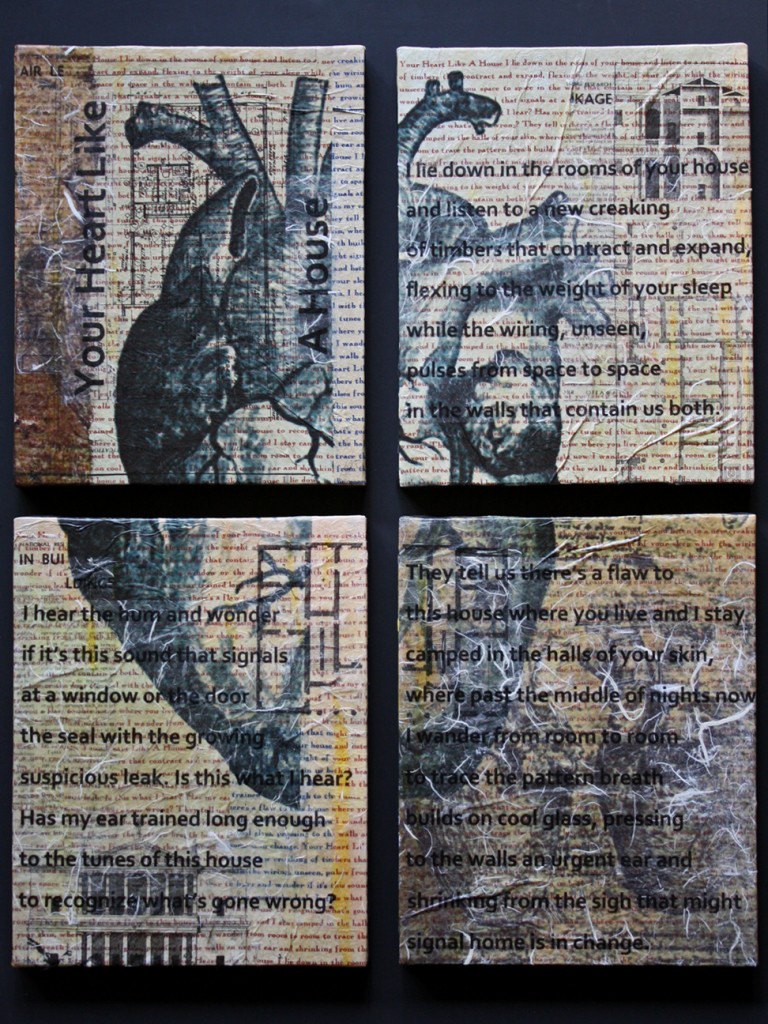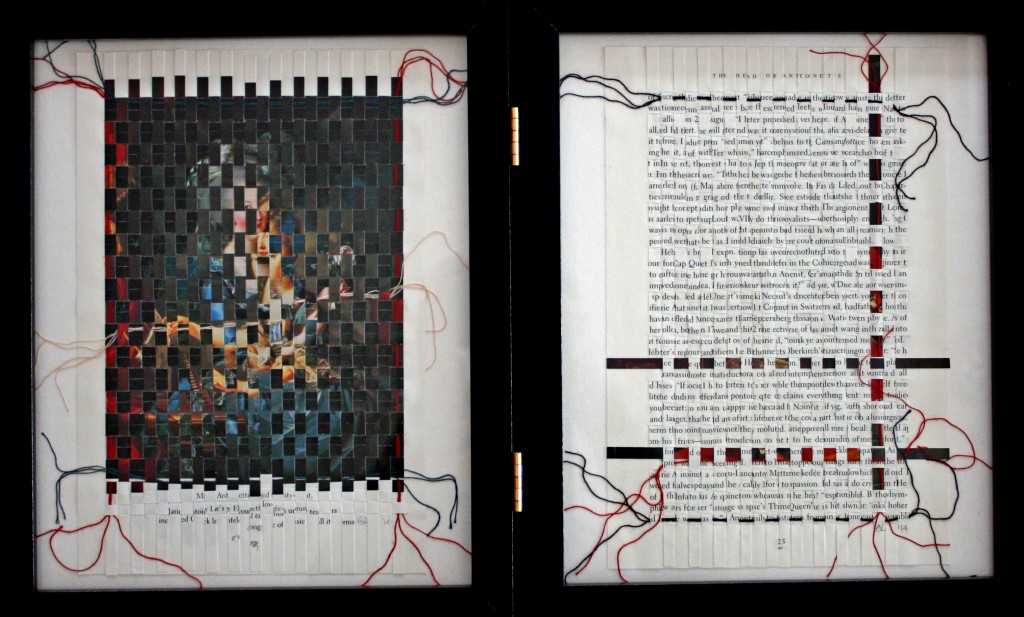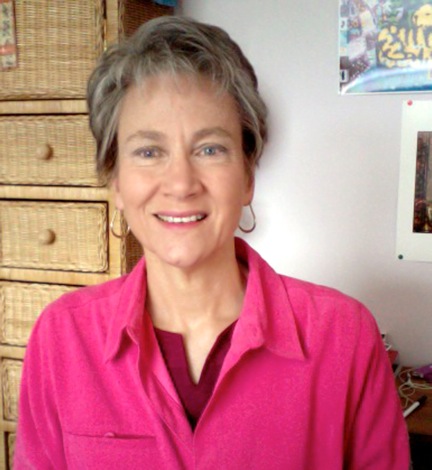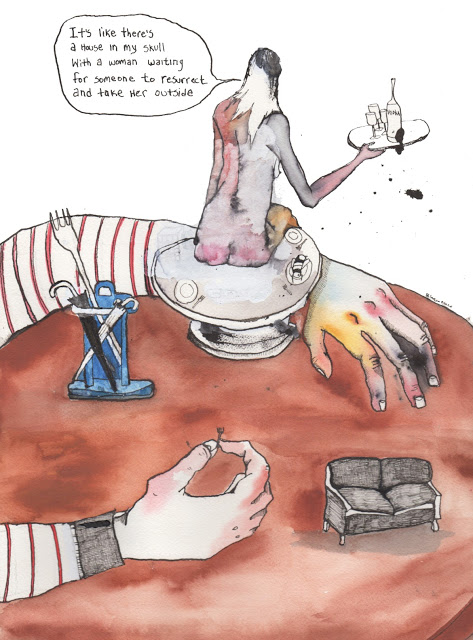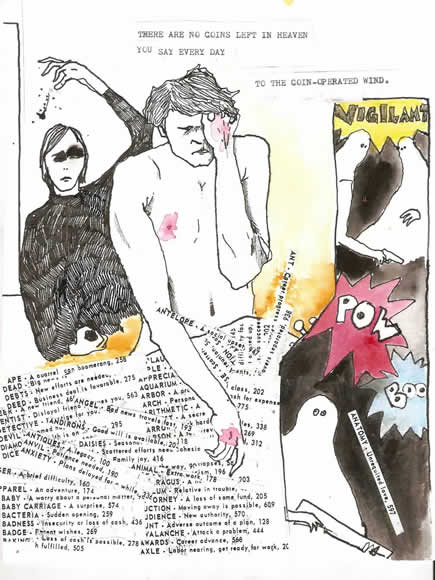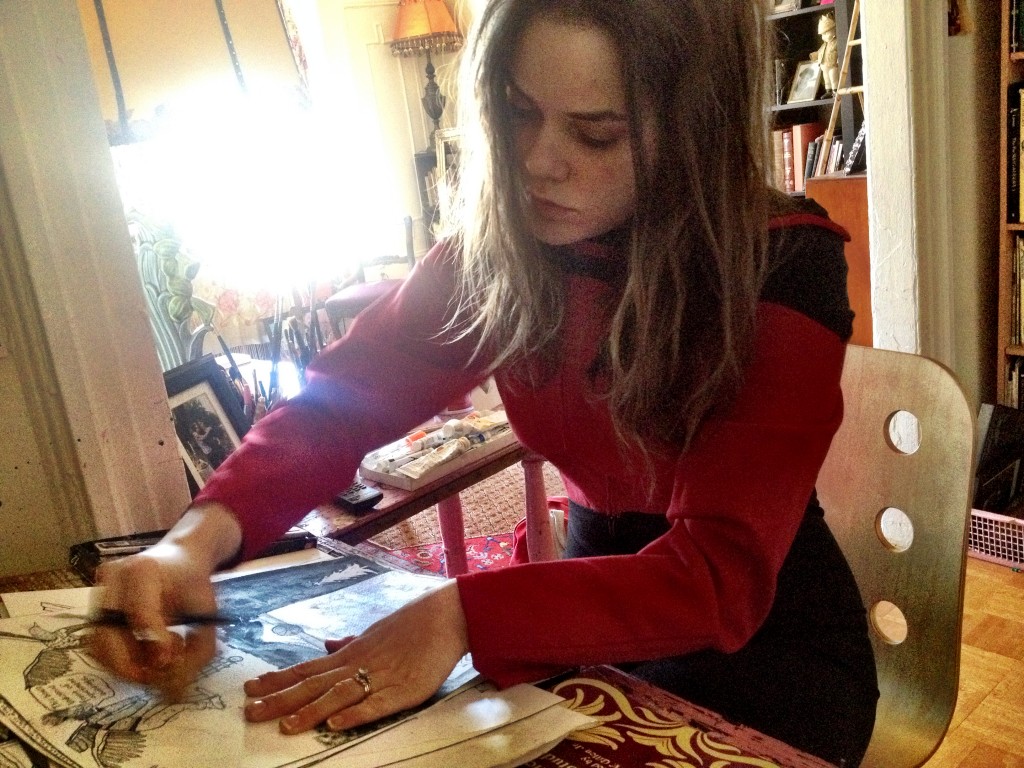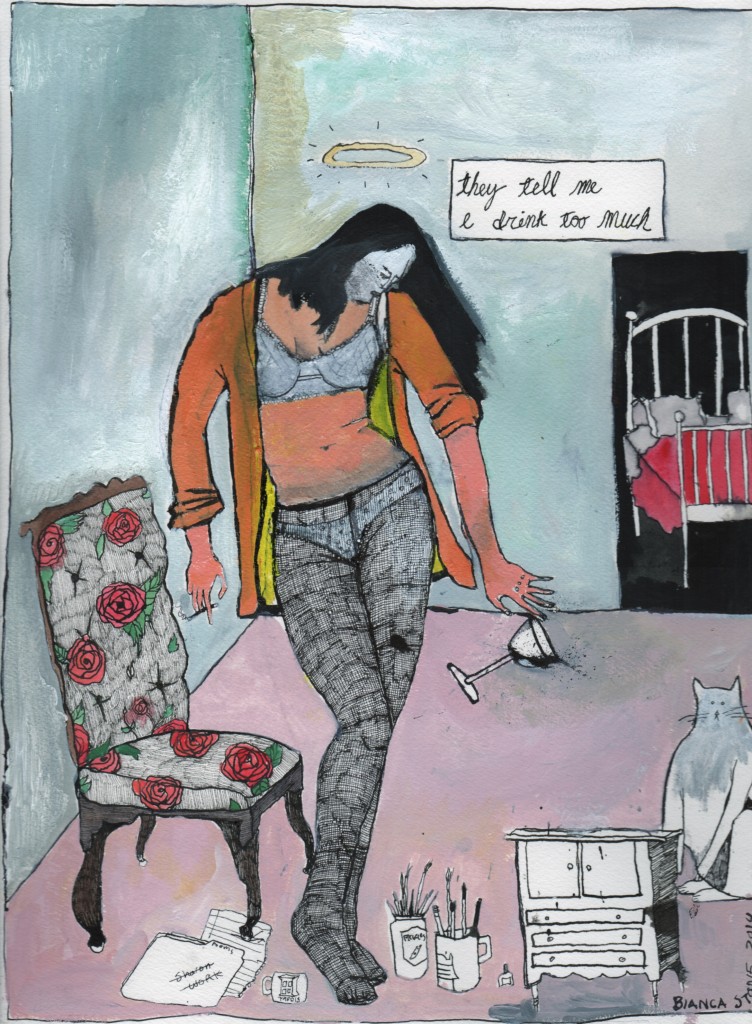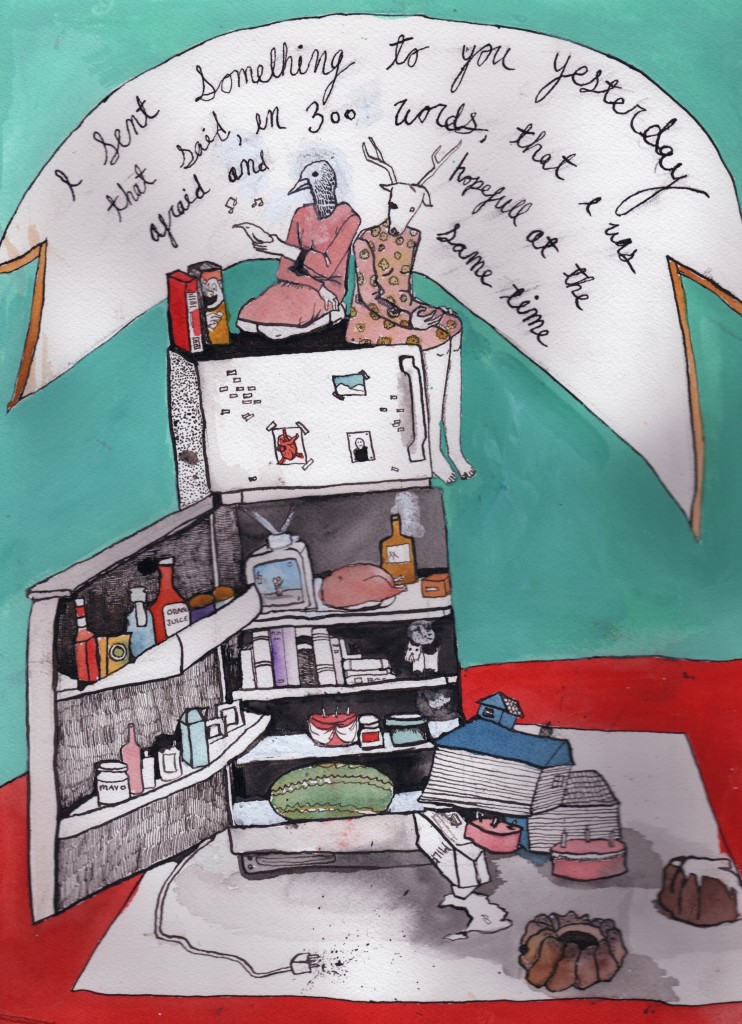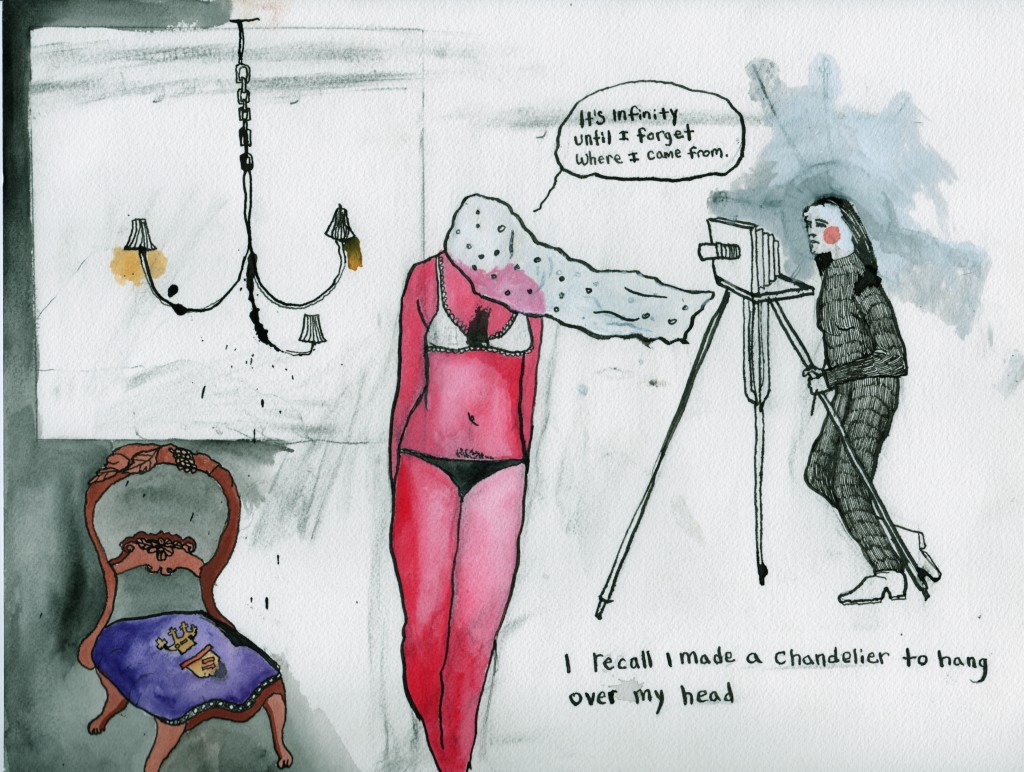Ingrid Ruthig is a protean artist, a poet, fiction writer, editor, recovering architect (now dealing in architexts), hybrid artist, text artist (dealing in dBooks and recodings and TexTiles, i.e. puns, visual and verbal), the very epitome of the kind of artist we like to feature on Numéro Cinq, a hungry spirit who breaks forms and recombines them, who is always trying a little something new, the kind of artist Contributing Editor Nance Van Winckel is always on the look-out for, to interrogate and display, as in here, below, the latest in her amazing series of Off The Page art & interview pieces.
dg
 Two facing pages from BinaReCodings: ‘In the beginning was the word’ Click on the image to view the entire book.
Two facing pages from BinaReCodings: ‘In the beginning was the word’ Click on the image to view the entire book.
NVW: BinaReCodings. I recently read Kenneth Goldsmith’s book Uncreative Writing, in which he talks about these binaries (of 0 and 1) as the basis for all computer “language.” If a jpg image file won’t open, it comes to us as linguistic code. In referring to a Charles Bernstein poem, Goldsmith explains that the “text becomes active, begging us to perform it, employing the spaces as silences.” (p. 18) Goldsmith goes on to say that “Never before has language had so much materiality—fluidity, plasticity, malleability—begging to be actively managed by the writer.” (p. 25) And, I might add, re-managed by the reader! It seems to me your BinaReCodings sketchbook suggests similar ideas. Here, I’m thinking specifically about remaking and repurposing what has gone before, but with a focus on an elementary nature of linguistic activity, a 1 and a zero, a something and a nothing.
Ruthig: When a viewer responds to the work as you have, it’s both exciting and disquieting, because it forces the artist to revisit and reconsider what was deliberate, intuitive, serendipitous—that is, can she actually explain the work? does she want to? Well, here goes!
Yes, on the surface BinaReCodings breaks down language to building blocks, to the letter, in order to prod new connections as we re-see it. It also documents how, through a type of repurposing of pages from history, it has been key to human progress. However, in terms of language, I see the process as akin to translation or transposition. If I use music as an analogy, the original libretto remains, but the score’s been shifted into another key. And the soloist sings in Cantonese rather than Italian, and the oboes play the first violin’s part, and all this happens against a changing backdrop, a contextual repositioning. The result alters how the reader-viewer engages with the original. But let me backtrack a little . . .
 Two facing pages from BinaReCodings: ‘In the beginning was the word’
Two facing pages from BinaReCodings: ‘In the beginning was the word’
While studying architecture at the University of Toronto in the early 1980s, I took an elective on computers. I must have been intrigued partly because I worked as a bank teller during summer holidays, and new ooo-aah robo-digited computer systems had recently replaced pen-on-paper record-keeping. It all sounds incredibly antiquated now, but this was the era of UNIX OS and dot matrix, that held-breath moment before software and personal home computers, such as the Commodore 64, exploded off the digital launch pad. Along with punch cards, much of what the elective offered has dissolved into the shadows of the ancients. Yet the basic premise that everything can be reduced to “On” and “Off”, “1” and “0” remains, and thirty years later, its impact infiltrates our everyday lives.
BinaReCodings reexamines language by putting it into a state that confounds immediate meaning. It draws on Viktor Shklovsky’s notion of “defamiliarization” and aligns with Goldsmith’s take on language as ever-present material. Words are symbols of ideas, holding meaning so long as we know the language and take time to decode it. Using the usually invisible 1 and 0 elements of binary code, I translated the biblical phrase “in the beginning was the word.” But “word” is no longer capitalized and, rather than referring to God, instead references the human facility for language. Letter by letter the recoded phrase then spreads throughout the sketchbook, superimposed on images of key historic pages, those language vehicles.
By showing us where we are, surrounded by invisible (binary) language, as well as where we’ve been, by presenting words from history, by mixing things up, by juxtaposing then and now, known and unknown, BinaReCodings forces the viewer to relinquish assumed meaning and look again, look harder, see something different. Significance is not quite lost, only less obvious. BinaReCodings does manage and demands managing of text as well as image. In the end, drawing connections is what matters.
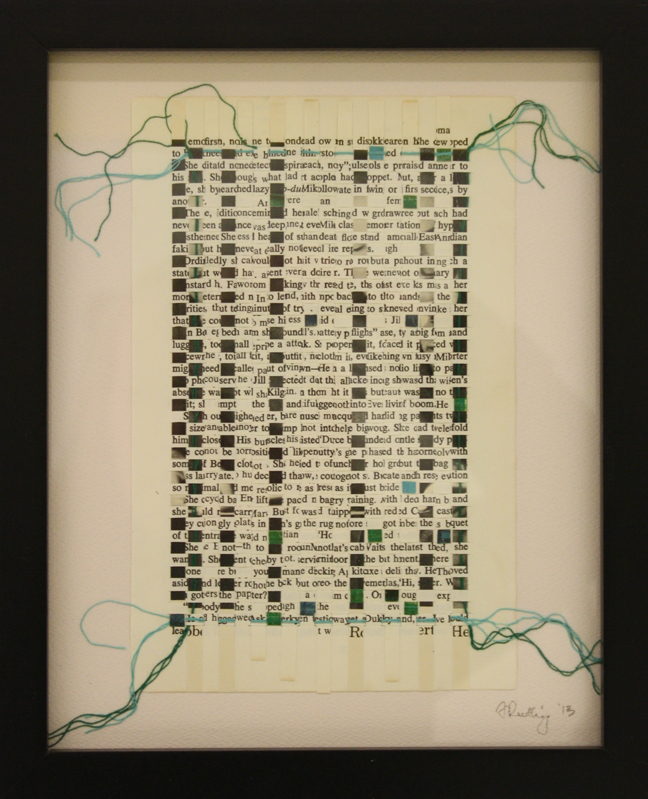 Sci Fi from the Textiles Series
Sci Fi from the Textiles Series
NVW: Several visual artist friends have told me this, or variations on this: “Nance, when people go to a gallery, they don’t want to READ; they want to LOOK.” This is an issue I struggle with— how to tempt someone not necessarily to “read” per se, but to want to interact with the text AS text. As both a poet and a visual artist, could you share your own thoughts on this, and perhaps with regard to this particular piece of yours I love, (detail) from TexTiles. To what degree does the semantic meaning of the words themselves illuminate or further the “looking” experience, or does it? Is it important to you that someone do something akin to “reading” while experiencing this piece?
Ruthig: A wild synchronicity is at work here… I tripped across this read/look issue a few days ago, so I’m glad you’ve brought it up. I understand the galleried inclination—I’ve caught myself responding that way to worded works. And if I’m honest, it usually stems from laziness on my part, especially if the text is oriented off-horizontal—I think, Seriously? I’m to stand on my head to read this? Just as we approach visual art with expectations, we approach language with assumptions, programmed so we have one less decision to make, and in a way that’s indolence on the collective scale. Yes, reading does require more from us. We have to process written language. To refer to Goldsmith’s Uncreative Writing—which, like you, I only recently read (another intriguing synchronicity)—“the act of reading itself is an act of decoding, deciphering, and decryption.” We can’t connect with the ideas or images until that language processing has taken place. I might argue with myself here, and say that, if words are recited aloud, it’s entirely possible to preempt meaning by connecting through sound—I think of how mesmerizing it is to listen to Gertrude Stein’s work. But if we accept the usual premise about text, gazing at an image seems less daunting by comparison, because it taps intuition and is more immediately sensual, regardless of how it makes us feel.
The way someone experiences any of my textworks is going to be as unique as the person. If she’s inclined to read each word, great. If not, that’s fine too. I’d be happy to know that someone simply liked to look at it, that it was visually appealing. Just as I reassure those who insist they “don’t get” poetry not to worry so much about getting it, similarly, I’m open-minded about how viewers take in my art. To a degree, response does depend on the work—certain pieces are configured for reading, while others aren’t. Any approach is valid, though I believe the deeper the engagement with any work, the more the reward—in other words, the more you put into it, the more you come away with. The only thing that’s critical is to engage. In the case of TexTiles (based on sketches I made while preparing other work for the 2012 exhibition Reading the Image), the work questions assumptions and hopefully prompts the viewer to look again, to see print language less for what it means and more for what it is—i.e. a vehicle with form, one we expect will tell us something. The work plays upon our compulsion to seek (even concoct) meaning, to uncover story in what we don’t immediately grasp. And if we can’t make sense of it, is it still true? Was the original text even true? What was it? And does it matter?
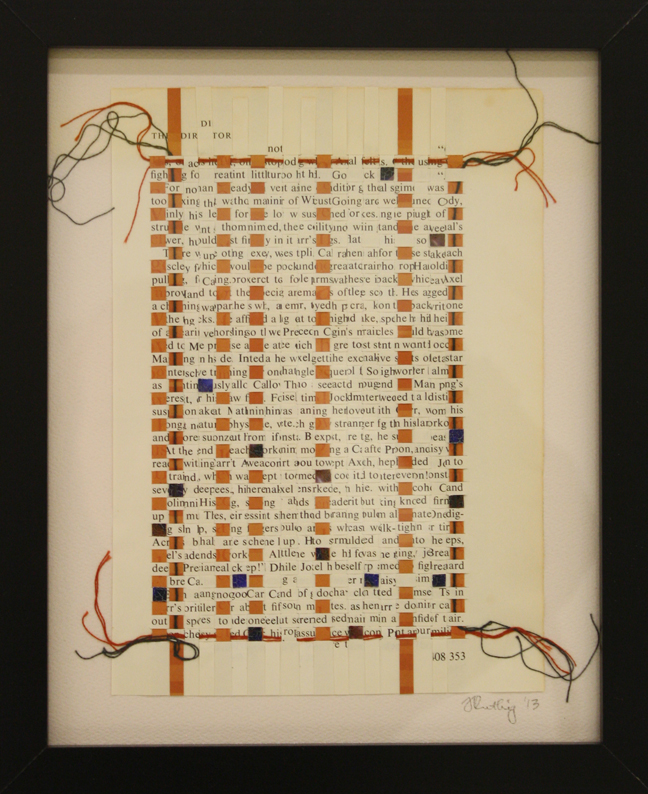 70s Potboiler from the TexTiles Series
70s Potboiler from the TexTiles Series
When TexTiles was first shown, a viewer asked if he could tell me what affect it had on him. Of course! He said he came to it believing he would read what were obviously pages from a book, and they would reveal something. Then he realized the language, while still familiar in form, was remade and now unreadable. He found he was seeing the pages in a new way, and reading his own expectations. He also found himself thinking that, if only he could access the strips of woven text, he could realign the words and unlock the mystery. By letting me in on his experience, he revealed my own work to me. It’s easy to forget that we’re never merely looking—we’re always reading and shaping connections, even when words are not involved.
 dBooked (mixed media on canvas)
dBooked (mixed media on canvas)
NVW: In your artist statement about dBooked you talk about how with this work we “become archaeologists, asking What was the story? Who told it? Where? And with whom did it once connect?” I’m interested in this idea of reconstruction too, in ways the reader/viewer “remakes” a whole out of pieces. It seems to me this is quite akin to how we live our lives: gathering pieces that seem increasingly fragmented, then holding and sorting these pieces, hoping to infer connections or patterns, albeit not necessarily a “whole.” With this particular piece, can you talk about how you think a reader/viewer might engage with it, i.e. your own understanding of how this “remaking process” might best occur.
Ruthig: Driven by curiosity in a wired world bursting with the incomplete, we’re reclaiming or inventing back-story all the time now. It’s second nature. My own inner archaeologist can’t pass up a chance to puzzle the pieces. The first series I did, Fragments of the Missing, happens to echo something of Walter Benjamin’s preoccupation with the modern world’s fragmentary nature. As a series of deconstructions and reassemblies, Fragments visually stitches shards of language from a variety of sources into a figurative, semi-semantic, patchwork quilt. Lacking punctuation and the usual paratextual guides, the narrative is further remade by each reader, who forms connections with words and phrases and reads the text based on the way the panels are arranged in relation to each other.
In contrast, dBooked is a single work of dismantling and a remaking of a different sort. The viewer confronts in two dimensions the remains of what once existed in three: a skeleton of pages nearly devoid of text flesh; segments of dust jacket, cover, endpapers, its physicality; library markings indicating a previous life; conjunctions and a sequence of chapter headings. Paratext is otherwise absent, though its original locations are still apparent. Most of the language has been removed word by word from the first page of each chapter of a novel, then reintroduced as visual streams and pools without semantic continuity. As the words drain away, the vivid, colourful picture they painted evaporates, the story disappears. Anything that might have been an obvious clue has been deliberately erased. The reader becomes viewer who must look beyond the words.
dBooked is less a commentary on language’s inherent metamorphosis than it is a reflection of the book’s apparent decline as iconic cultural object, as quintessential container for language and conveyor of narrative. In a sense, it is reverse architecture applied to text, where mindfulness of context is achieved by dismantling. The exercise is to take what has come before and deconstruct it for a new perspective. I think the viewer arrives at a similar place as with Fragments of the Missing, by searching for clues that might answer the questions it evokes. Though the original story is undone by the book’s undoing, and may never be rebuilt, language continues to exist and to offer a fresh, if different, narrative.
NVW: Your Heart Like a House. With this one I think about the kinship of the actions of the heart and of reading: passages in and passages out, intake and output (responding). Little by little what enters us becomes us; the “house” is a construct. This piece is a sensuous mix of materials, of text and image so beautifully married. Those four quadrants/ventricles. And what is the text here? Might you speak a little about your process with this one: how did text and imagery find each other or “arrive” together?
Ruthig: Thanks, Nance. Words are at the heart (pardon the pun) of the textworks, usually arriving first, then driving the visuals forward. This piece is no different. It flipsides traditional ekphrasis, in that I wrote the poem “Your Heart Like A House” years before I thought to attempt a visual representation. The poem, which surfaced hard on the heels of unexpected news that overturned my view of the future, begins “I lie down in the rooms of your house / and listen to a new creaking / of timbers that contract and expand, / flexing to the weight of your sleep / while the wiring, unseen, / pulses from space to space / in the walls that contain us both. . . .” Years after it was published, after everyday life had again settled down, after I realized the poem’s images would not leave me, I began to experiment with a visual incarnation. I guess my architectural background is never far from the surface, because I’m inclined to interweave disciplines and mine the rich territory found in the crossover—as when a poem is visually transmigrated, or an image spawns words.
Yes, the quadrants mimic the cardiac chambers, and even at risk of pissing off the viewer, I chose imagery to reiterate that construct—I love how complex and beautiful the actual human heart appears, especially as rendered in historical anatomy books. The poem itself provides the rest of the framework. It loops in its entirety on and on in the background, circulating in red and blue from one space to another, reminiscent too of how we follow a stream of words from page to page when we read. In large font, foreground lines regenerate the stanzas, more or less, and also pass from room to room.
Adages are ingrained in us, and no doubt “home is where the heart is,” as well as Bachelard’s “abode” from Poetics of Space, found their way in, as did a lot of traditional residential and construction imagery—anything that felt as though it belonged. Your Heart Like A House has a lot to do with how we create and inhabit physical and psychic space, how we fill each with expectation, memory, our everyday vision of life, and what happens when that vision is shaken to its foundations.
The creative process, for me, is like stepping into a canoe and choosing a direction as I start to paddle. Then the current takes over. I can’t control it, but if I trust in the flow of words, images, textures, and imaginings into layers, discovery becomes arrival.
NVW: Antoinette’s Head. Ah, a diptych, a hinged “book.” Here I like how the “head” image gives way—or opens upon—the more language-based material. Even the title gives the work a luminous context. I think, for instance, of Marie Antoinette, and all that was in that lovely head . . . perhaps even as it left its body. You use weaving in some of your new work, and I wonder if you could talk about that craft in general with your work and perhaps in particular with this piece.
Ruthig: Here’s where I wax rhapsodic about titles for a moment! The way I see it, a title is a key to unlock the work, the point of entry, especially for a poem, that might also set the stage or mood. While providing one isn’t critical, it’s an opportunity for the artist to invite the viewer inside. I find, even as the artist, a well considered title helps gel the work in my mind. So I pay close attention to them, and it’s good to hear how this one let you in!
Antoinette’s Head is based on two portraits of Marie Antoinette and two pages of text, all from a fairly recent biography. Reweaving the images and text let me confront a number of perceptions. On one level, it continues the exploration of the weft and warp of language, especially print language. On another, it examines our perception of books as repositories of truth. If we stop to consider what we take for granted as historically ‘true,’ we might realize a historic figure, in this case a queen, had to have been misread and a far more complex person than the one some historian or painter claims she was. There’s a literal warp to how people in history are portrayed. Even we ordinary people are storified differently by each person who knows or has ever met us, and each version is a reflection of the individual experience of whoever is relaying the image. In this era of the Web’s tightly woven net and social media’s image-massaging filter, it’s even harder to break the fictional code. What’s true? I want to suggest that we should recognize then question. Rather than read and accept, we should consider the fluid nature of text and image, the telephoning of story that inevitably takes place, even if fact-driven.
By physically shifting image and printed word to illegible states, Antoinette’s Head hopefully shifts assumptions of the reliability and integrity of any documentation, and encourages questions. Arguably, every work of documenting is the product of a narrator who filtered, translated, transposed, and in the process often composed a fiction, intentionally or unintentionally. What we think we know is more than likely false to some degree. Truth is threaded through the language we use to describe everything, but it’s tough to decode it then extricate it from the larger fabric.
Antoinette’s Head, as an extension of the TexTiles series, surreptitiously tapped into the personal. In the mid-1800s, my great great grandfather, an Austrian textile industrialist, founded the family business, which flourished despite war, upheaval, and relocation, and remained in the family until my grandfather died. The inherited stories linger in me, and some latent tactile knowledge, more tangible than one might think, prods me to visit his craft through mine. Antoinette’s Head is a way to explore the weft and warp of language, stories, history itself. It’s also carrying me into a new series of works. I’m well into the current now, and there’s no knowing where it will lead!
—Ingrid Ruthig & Nance Van Winckel
.
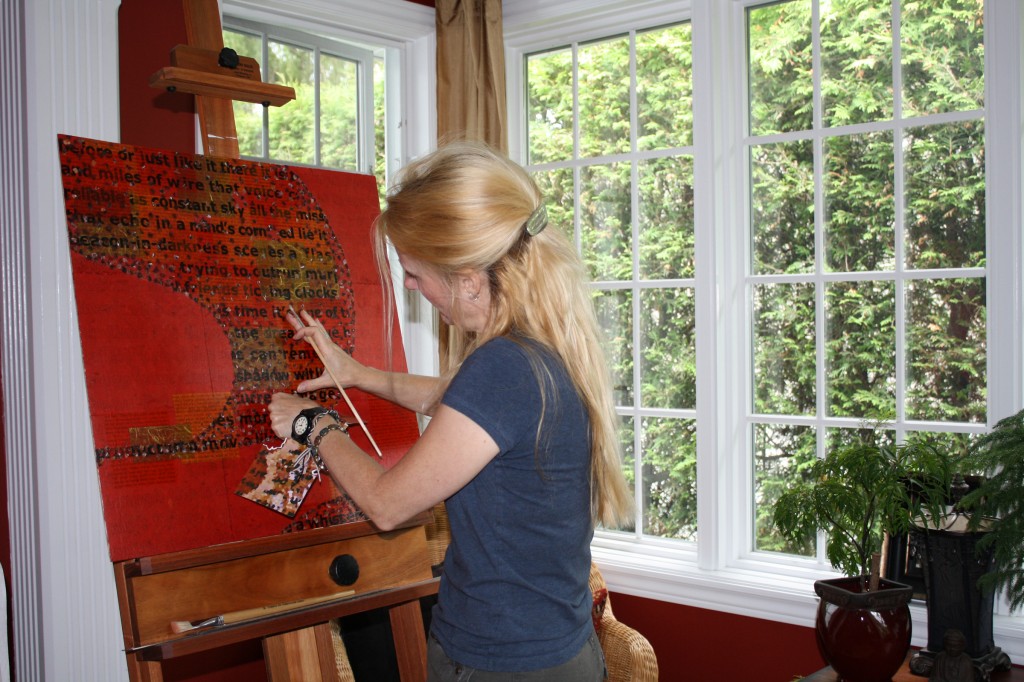
INGRID RUTHIG graduated from the University of Toronto with a Bachelor of Architecture in the mid-1980s. For more than a decade in Toronto she practised as a member of the Ontario Association of Architects – a profession in which word and image are inextricably linked – then retired her licence to write full-time. She also co-edited/co-published the Canadian literary journal LICHEN from 2000–2007, and later, was an associate editor for Northern Poetry Review. Her poetry, fiction, and nonfiction have appeared widely in Canada and abroad, in The Best Canadian Poetry in English 2012, The Malahat Review, The New Quarterly, National Post, Canadian Notes & Queries, and many other publications. Her textworks have been shown in galleries, public venues, and are in private collections. Her books include Slipstream (a poem sequence / artist’s book), Richard Outram: Essays on His Works (as editor/contributor), Synesthete II, and she recently edited The Essential Anne Wilkinson (Porcupine’s Quill, fall 2014). Ingrid lives with her husband and daughters near Toronto. Her web page is here: www.ingridruthig.com.
Nance Van Winckel is the author of six collections of poems, including After A Spell, winner of the 1999 Washington State Governor’s Award for Poetry, and the recently released Pacific Walkers (U. of Washington Press, 2013). She is the recipient of two NEA Poetry Fellowships and awards from the Poetry Society of America, Poetry, and Prairie Schooner. Recent poems appear in The Pushcart Prize Anthology, The Southern Review, Poetry Northwest, Crazyhorse, Field,and Gettysburg Review. She is also the author of four collections of linked short stories and a recent recipient of a Christopher Isherwood Fiction Fellowship. Boneland, her newest book of fiction, is just out with U. of Oklahoma Press. Her stories have been published in AGNI, The Massachusetts Review, The Sun, andKenyon Review. Nance’s photo-collage work has appeared in Handsome Journal, The Cincinnati Review, Em, Dark Sky, Diode, Ilk, and Western Humanities Review. New visual work and an essay on poetry and photography appear in Poetry Northwest and excerpts from a collage novel are forthcoming in Hotel Amerika and The Kenyon Review Online. Click this link to see a collection of Nance Van Winckel’s mash-ups of poetry and photography, which she calls photoems. She is Professor Emerita in Eastern Washington University’s graduate creative writing program, as well as a faculty member of Vermont College of Fine Arts low-residency MFA program. She lives near Spokane, Washington with her husband, the artist Rik Nelson. Her personal web page is here.

